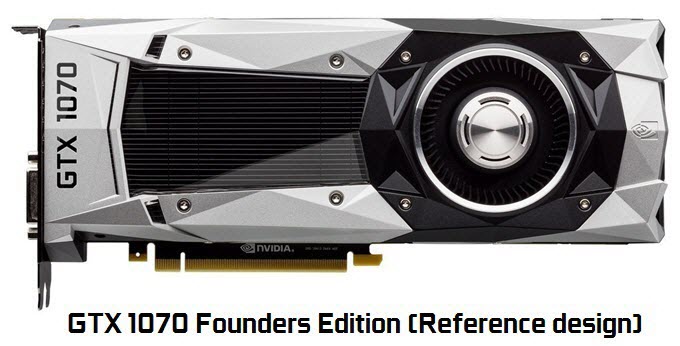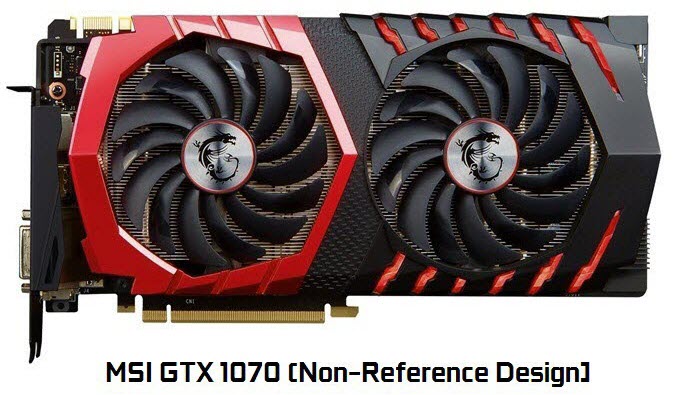Graphics cards do come in many models, sizes, and configurations. Choosing the right graphics card is very important because it is not a cheap device and you don’t want to go through trouble fitting it inside your PC case. Sometimes you might have come across terms like reference and non-reference graphics cards when looking to buy a new graphics card for your PC. It is very important to know what they really mean to make a well-informed decision when buying a graphics card. So here in this post, I am going to tell you about reference and non-reference video cards and how they are different from each other.
Check out: Important Graphics Card Technical Terms
Reference Graphics Cards
Reference Graphics Cards are the ones that are built on the specifications laid out by GPU manufacturers which are NVIDIA or AMD. These cards have the default clock frequencies for both GPU and Memory as specified by Nvidia / AMD in their specifications. This means these cards are not overclocked and they strictly follow original specs for reference cards. Reference Cards are also known as Standard graphics cards or Stock graphics cards. They also have the same design, size, and HSF as the original or reference cards made by GPU manufacturers.
You may overclock these reference graphics cards to increase their performance using good graphics card overclocking software. The main advantage of reference cards is that they offer rock-solid stability, are solidly built, and are compatible with Aftermarket graphics card coolers.
What is Founders Edition Graphics Card from NVIDIA?
Nvidia only makes only a handful of graphics cards for its top-end GPUs. These original or reference NVIDIA’s graphics cards are known as Founders Edition. The Founders Edition is a new name for Nvidia’s reference graphics cards. Other graphics card manufacturers or NVIDIA partners such as EVGA, ASUS, MSI, ZOTAC, etc. also offer Founders Edition of top-end GPUs but they are exactly the same as original Nvidia’s reference cards or stock design.
 The Founders Edition graphics cards from third-party manufacturers have the same design, GPU and memory frequencies, memory size, physical size, stock cooler, or HSF (heatsink fan) as the original ones. Currently, the top Founders Edition Graphics Cards from Nvidia are:
The Founders Edition graphics cards from third-party manufacturers have the same design, GPU and memory frequencies, memory size, physical size, stock cooler, or HSF (heatsink fan) as the original ones. Currently, the top Founders Edition Graphics Cards from Nvidia are:
- GeForce GTX 1060 Founders Edition
- GeForce GTX 1070 Founders Edition
- GeForce GTX 1070 Ti Founders Edition
- GeForce GTX 1080 Founders Edition
- GeForce GTX 1080 Ti Founders Edition
Founders Edition graphics cards are generally more expensive than non-reference graphics cards. They also have less overclocking capability because their heatsink and fan are not designed for that. The main advantage of Founders Edition cooling is that its heatsink and fan (blower fan) are designed to push the hot air out from the backside of the card rather than keeping it in the case. This may come in handy for some users as it helps in reducing the overall temperature of the computer case. Other advantages include high stability, robust design, and wide compatibility with aftermarket graphics card coolers that include both air coolers and water blocks.
You may also buy the founders edition graphics card from Nvidia’s official website and also from other online websites such as Amazon.com.
So to sum it up Founders Edition = Stock Design + Stock Specifications
Pros
- Excellent Stability
- Original design
- Compatible with Aftermarket Coolers
Cons
- Expensive
- Less room for Overclocking
Non-Reference Graphics Cards
Non-Reference Graphics Cards are the ones that are manufactured by GPU’s manufacturer partners such as EVGA, MSI, Sapphire, Asus, Gigabyte, etc. These cards may have different sizes, and designs and are fitted with their own custom HSF or cooler. Non-reference cards are generally overclocked to some extent to provide better performance in games and graphics-intensive applications. You may overclock these cards further and the custom graphics card cooler keeps the temperature well under check even at full load. Some of these non-reference cards also come with water cooling or liquid cooling that reduces the temperature to a further 20 ° C and provides more room for overclocking.
Non-reference graphics cards are generally cheaper than the Founders Edition cards having the same GPU and provide better performance per dollar. Only the cards that come with liquid cooling are a bit more expensive than the Founders Edition cards.
Pros
- Better Cooling
- Better Performance
- Relatively Cheaper
- Various choices available
- Good Overclocking Potential
Cons
- Some are bigger in size
Reference vs. Non Reference cards – Who is the winner?
The answer to this question is not straightforward forward and it comes to the user’s personal preference. Some like the stability and solidity of the Founders Edition cards and some prefer the extra potential of the non-reference cards at a relatively cheaper price. But if you are a performance enthusiast who likes overclocking their cards to get the maximum performance out of them then it is better to go with non-reference cards with a better custom cooler.
Must Read: Rebrand, Rebadge vs Refresh Graphics Card
Final Words
Well, in the end, I would like to say that I have clearly pointed out the differences between reference and non-reference graphics cards along with their advantages and disadvantages. If you have any suggestions or want to ask something then you can reach me by leaving a comment below.
(*This post may contain affiliate links, which means I may receive a small commission if you choose to purchase through the links I provide (at no extra cost to you). Thank you for supporting the work I put into this site!)


![AIO Fans Intake or Exhaust? [Ideal AIO Radiator Mounting Positions] AIO Fans Intake or Exhaust? [Ideal AIO Radiator Mounting Positions]](https://graphicscardhub.com/wp-content/uploads/2023/03/aio-radiator-fans-intake-or-exhaust-211x150.jpg)

Hi, I have a reference card gtx1070 Ti from zotac. Its from a pre-built PC. I wonder, how come I don’t see a lot of information about it? Its even missing from your list of reference cards above.
The article was written before its release but i have now included it.
If I were to use the pcb of a graphics card and not the cooler it was made with, which would be the better choice. another words, if I wanted to water cool a 2080ti, and im going to be replacing the heatsinks and fans, would a reference card be better than a non-reference card? there has been some debate whether or not nvidia keeps the higher quality parts for their reference/founders edition cards. personally I’ve seen some youtube videos to confirm this theory but the performance gain isn’t “substantial”. my question is, would a water cooled reference card out perform and outlive a non-reference card If they were both water cooled? aside from what blocks will fit and everything else, just numbers to numbers. What would your choice be?
Well, aftermarket GPU coolers and waterblocks are mostly designed for the founders edition cards or cards with reference PCB & design. Lately, nvidia is certainly keeping best GPUs for their founders edition cards and they may perform and overclock a little better. I think a water cooled reference card might perform better but not by a significant margin.